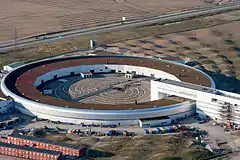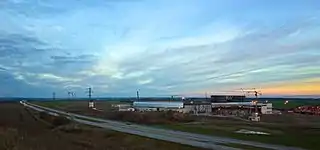MAX IV Laboratory
MAX IV is a next-generation[3][4] synchrotron radiation facility in Lund, Sweden.[5] Its design[6][7] and planning has been carried out within the Swedish national laboratory, MAX-lab, which up until 2015 operated three accelerators for synchrotron radiation research: MAX I (550 MeV, opened 1986), MAX II (1,5 GeV, opened 1997) and MAX III (700 MeV, opened 2008). MAX-lab supported about 1000 users from over 30 countries annually. The facility operated 14 beamlines with a total of 19 independent experimental stations, supporting a wide range of experimental techniques such as macromolecular crystallography, electron spectroscopy, nanolithography and production of tagged photons for photo-nuclear experiments. The facility closed on 13 December (St Lucia dagen) 2015 in preparation for MAX IV.
 MAX IV aerial photo from 2014 | |
| General properties | |
|---|---|
| Accelerator type | Synchrotron light source |
| Beam type | Electrons |
| Target type | Light source |
| Beam properties | |
| Maximum energy | 3 GeV[1] |
| Maximum current | 500 mA[1] |
| Physical properties | |
| Circumference | 528 metres (1,732 ft)[1] |
| Location | Lund, Sweden |
| Coordinates | 55.727°N 13.233°E |
| Institution | Lund University |
| Dates of operation | 2016 - present[2] |
| Preceded by | MAX III[2] |

On 27 April 2009 the Swedish Ministry of Education and Research, Swedish Research Council, Lund University, Region Skåne and Vinnova, a Swedish government funding agency, decided to fund the research center.[8]
The new laboratories, including two storage rings and a full-energy linac is situated in Brunnshög in Lund North East. The inauguration of MAX IV took place 21 June 2016, on the day of summer solstice.[8] The larger of the two storage rings has a circumference of 528 meters, operates at 3 GeV energy, and has been optimized for high-brightness x-rays. The smaller storage ring (circumference 96 meters) is operated at 1.5 GeV energy and has been optimized for UV.[9] There are also plans for a future expansion of the facility that would add a free-electron laser (FEL) to the facility, but is yet to be funded.[8]
There are currently 16 beamlines at the facility with 10 of them located around the 3 GeV ring, 5 around the 1.5 GeV ring and one at the linear accelerator.[10]
References
- "3 GeV storage ring". maxiv.lu.se. MAX IV. Retrieved 20 July 2022.
- "History". maxiv.lu.se. MAX IV. Archived from the original on 25 November 2020. Retrieved 20 July 2022.
- Einfeld, Dieter (2 November 2014). "Multi-bend Achromat Lattices for Storage Ring Light Sources". Synchrotron Radiation News. 27 (6): 4–7. Bibcode:2014SRNew..27....4E. doi:10.1080/08940886.2014.970929. ISSN 0894-0886. S2CID 120677730.
- P.F., Tavares; S.C., Leemann; M., Sjöström; Å., Andersson (1 September 2014). "The MAX IV storage ring project". Journal of Synchrotron Radiation. 21 (5): 862–77. doi:10.1107/S1600577514011503. ISSN 1600-5775. PMC 4181638. PMID 25177978.
- "Världens starkaste synkrotron invigs - Umeå universitet". www.teknat.umu.se (in Swedish). 21 June 2016. Archived from the original on 18 September 2016. Retrieved 27 May 2017.
- M., Johansson; B., Anderberg; L.-J., Lindgren (1 September 2014). "Magnet design for a low-emittance storage ring". Journal of Synchrotron Radiation. 21 (5): 884–903. doi:10.1107/S160057751401666X. ISSN 1600-5775. PMC 4181640. PMID 25177980.
- E., Al-Dmour; J., Ahlback; D., Einfeld; P.F., Fernandes Tavares; M., Grabski (1 September 2014). "Diffraction-limited storage-ring vacuum technology". Journal of Synchrotron Radiation. 21 (5): 878–83. doi:10.1107/S1600577514010480. ISSN 1600-5775. PMC 4181639. PMID 25177979.
- "History – MAX IV". www.maxiv.lu.se. Archived from the original on 25 November 2020. Retrieved 27 May 2017.
- "Accelerators – MAX IV". www.maxiv.lu.se. Archived from the original on 11 June 2017. Retrieved 27 May 2017.
- Rift, Geer (8 November 2021). "Beamlines & accelerators". MAX IV. Retrieved 16 October 2022.
External links
- Website of the MAX IV Laboratory
- Lightsources.org, information about the world's synchrotron and free electron laser light source facilities
- International evaluation of the MAX IV concept (2006), in .pdf format
- Status of the MAX IV Laboratory, article published by Taylor & Francis in Synchrotron Radiation News on 1 February 2016, available online: http://www.tandfonline.com/doi/full/10.1080/08940886.2016.1124683
- MAX IV is Ready to Make the Invisible Visible, article published by Taylor & Francis in Synchrotron Radiation News on 2 December 2016, available online: http://www.tandfonline.com/doi/full/10.1080/08940886.2016.1244463